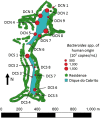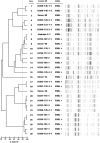Antibiotic Resistance in Enterobacteriaceae from Surface Waters in Urban Brazil Highlights the Risks of Poor Sanitation
- PMID: 30994094
- PMCID: PMC6553890
- DOI: 10.4269/ajtmh.18-0726
Antibiotic Resistance in Enterobacteriaceae from Surface Waters in Urban Brazil Highlights the Risks of Poor Sanitation
Abstract
Surface waters are an unappreciated reservoir of antimicrobial resistance (AMR). Poor sanitation brings different species of environmental bacteria into contact, facilitating horizontal gene transfer. To investigate the role of surface waters as potential reservoirs of AMR, we studied the point prevalence of fecal contamination, AMR genes, and Enterobacteriaceae in an urban lake and rural river system in Northeast Brazil in comparison with a lake and sewer system in Northeast Ohio in the United States. Surface water samples were examined for evidence of human fecal contamination using microbial source tracking and screened for plasmid-mediated fluoroquinolone resistance and carbapenemase genes. Enterobacteriaceae were detected using selective agar followed by antimicrobial susceptibility testing and detection of AMR genes by microarray, and classified by repetitive sequence-based polymerase chain reaction and multilocus sequence typing. Concentrations of human fecal bacteria in the Brazilian urban lake and sewage in Northeast Ohio were similarly high. Filtered water samples from the Brazilian urban lake, however, showed the presence of bla OXA-48, bla KPC, bla VIM-2, qnrS, and aac(6')-lb-cr, whereas only bla VIM-2 was identified in raw sewage from Northeast Ohio. From the Brazilian urban lake, 85% of the Enterobacteriaceae (n = 40) cultured were resistant to at least one clinically important antibiotic, including ST131 Escherichia coli harboring the extended-spectrum beta-lactamase CTX-M. Although two isolates demonstrated polymyxin resistance, mcr-1/2 was not detected. Our findings indicate that surface waters in an urban Brazilian site can serve as an environmental reservoir of AMR and that improving wastewater treatment and sanitation generally may ameliorate AMR dissemination.
Figures




References
-
- Woolhouse MEJ, Ward MJ, 2013. Microbiology. Sources of antimicrobial resistance. Science 341: 1460–1461. - PubMed
-
- Vaz-Moreira I, Nunes OC, Manaia CM, 2014. Bacterial diversity and antibiotic resistance in water habitats: searching the links with the human microbiome. FEMS Microbiol Rev 38: 761–778. - PubMed
-
- Szekeres E, Chiriac CM, Baricz A, Szőke-Nagy T, Lung I, Soran M-L, Rudi K, Dragos N, Coman C, 2018. Investigating antibiotics, antibiotic resistance genes, and microbial contaminants in groundwater in relation to the proximity of urban areas. Environ Pollut 236: 734–744. - PubMed
-
- Huijbers PM, Blaak H, de Jong MC, Graat EA, Vandenbroucke-Grauls CM, de Roda Husman AM, 2015. Role of the environment in the transmission of antimicrobial resistance to humans: a review. Environ Sci Technol 49: 11993–12004. - PubMed
Publication types
MeSH terms
Substances
Grants and funding
LinkOut - more resources
Full Text Sources
Medical
Miscellaneous

